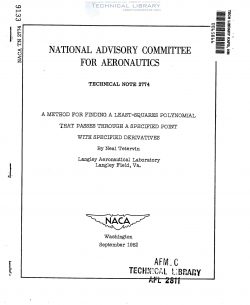naca-tn-2774
- Version
- 126 Downloads
- 301.76 KB File Size
- 1 File Count
- January 17, 2017 Create Date
- January 17, 2017 Last Updated
National Advisory Committee for Aeronautics, Technical Notes - A Method for Finding a Least-Squares Polynomial that Passes Through a Specified Point with Specified Derivatives

Recently it became necessary to be able to find the velocity and
the rate of change of velocity along the surface at any point on the
forward portibn of a symmetrical airfoil at zero angle of attack. The
given data consisted of values of the velocity at unequal intervals
along the surface and of the first derivative of the velocity at the
stagnation point. The given velocity at one of the points seemed to be
slightly in error.
In the development of a method for finding the velocity and its
first derivative, a procedure was needed for obtaining a third—degree
polynomial that passes through a specified point with a specified slope
and is a least—squares curve for other points spaced at unequal intervals
of the independent variable. A search of the available literature
(refs. 1 to 3) in which the least-squares method is discussed failed,
however, to disclose a procedure that combines the least-squares method
with the requirement that the polynomial pass through a specified point
with a specified first derivative. Such a procedure, therefore, had to
be developed.
In the course of the analysis, it became evident that its scope
could easily be expanded to provide a method for finding an mth-degree
polynomial that passes through a specified point with (m - j) specified
derivatives (1 g jԤ m) and, moreover, is a least-squares polynomial for
the remaining points. The specified (m - j) derivatives are not neces-
sarily the first (m - j) derivatives.
The method presented should be useful when the value of a function
or the value of a function and some of its derivatives are known from
theory at one value of the independent variable and experimentally
obtained values of the function are available for other values of the
independent variable. An example is the fitting of a polynomial to the
portion of a laminar-boundary—layer velocity profile near the surface.
In this case the value of the velocity and some of the derivatives of
the velocity are known at the surface from theory and measured values
of the velocity are available at a number of points through the boundary
layer. The procedure should also be useful when it is necessary to
divide the total range of the independent variable into convenient
intervals and to find a least-squares polynomial for the points in each
interval. The polynomial can then be made to pass through the point
given by the preceding polynomial at the end of the preceding interval
with the required derivatives. Examples are the fitting of an airfoil
velocity distribution by a number of polynomials and the fitting of a
boundary-layer velocity profile by polynomials.
| File | Action |
|---|---|
| naca-tn-2774 A Method for Finding a Least-Squares Polynomial that Passes Through a Specified Point with Specified Derivatives.pdf | Download |

Comment On This Post